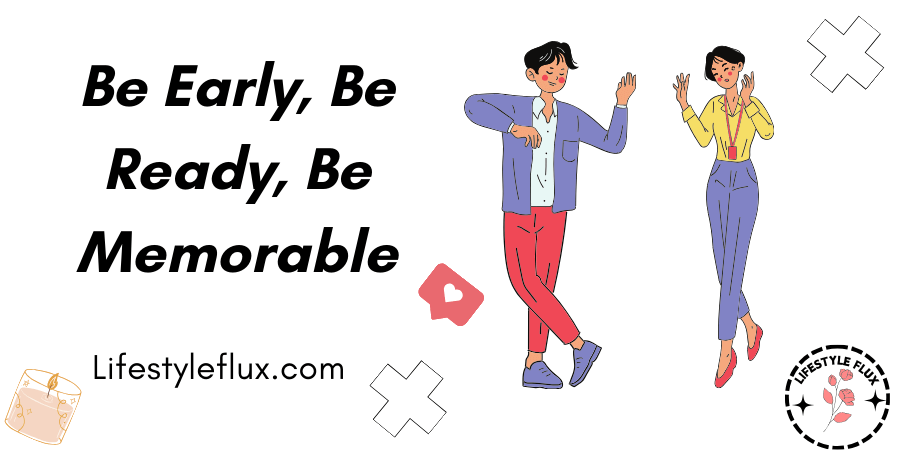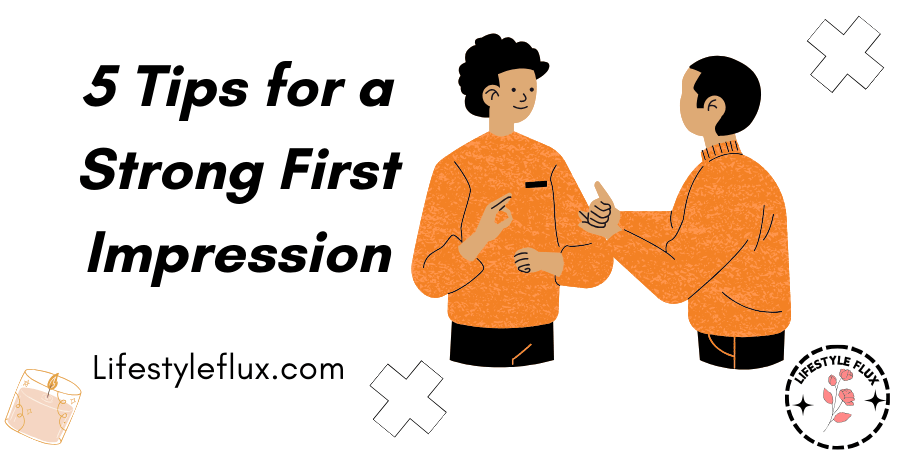First impressions are powerful. In just a few seconds, people form opinions about you, which can be difficult to change.
That’s why knowing how to make a great first impression is essential, whether meeting a potential employer, a new friend, or a business connection.
You don’t need to be the most charming or eloquent person in the room. Instead, it’s about using the right strategies to present yourself in the best light.
In this article, we’ll explore five key techniques to help you leave a lasting, positive impact on anyone you meet.
From the way you communicate to the importance of punctuality, these simple yet effective tricks will ensure you start every interaction on the right foot.
Table of Contents
1. EXPRESSIVE EVIDENCE
I’m sure you recognize this classic interview question: what are your strengths and weaknesses? You’d be surprised how often this question ruins first impressions.
It’s not because people don’t know what to say. It’s because they say it the wrong way. If someone asks about your strengths, you shouldn’t use it as an excuse to brag.
This kind of arrogance will never earn you any points because there’s nothing impressive about it. You can tell them you’re extremely intelligent and the hardest worker they’ve ever met.

But does that really mean anything? Anyone can say anything about themselves. Most interviewers have heard these baseless descriptors hundreds of times before. They know not to take them at face value.
So, what’s the best way to sell your strengths? Instead of telling them what kind of person you are, show them. Present concrete evidence. Then, let them figure it out for themselves.
Let’s say you want an employer to know that you’re an accomplished graphic designer. You could rave about how talented you are. But isn’t it more effective to come prepared with a portfolio?
That way, they can look at your work and judge you independently. If they decide you’re talented, their decision is worth way more than your bragging will ever be.
2. CONTROL SPEAKING STYLE
Speech is one of many pieces of body language you don’t pay much attention to. Just like you unconsciously cross your arms or tap your feet, you adjust your voice without noticing what you’re doing.
Your volume might decrease when you’re around someone you find intimidating. You might talk faster when you’re under pressure or giving a presentation. Whether or not you realize it’s happening, vocal change affects how people perceive you.
Volume, clarity, speed, tone, and variability suggest different things about your confidence and comfort. Those aren’t the only things affected by speech; however, confidence and comfort are essential for making a good first impression. Let’s say you’re going in for an interview.
How would displaying confidence and comfort increase your chances of getting the job? Well, confidence lets the interviewer know something significant about you. You believe in yourself.
You have faith in your ability to accomplish and achieve. If you genuinely think you can do the job, they’re much more likely to agree with you. Showing comfort has a similar positive effect.
When you’re calm and collected, you appear much more reliable than someone who is nervous and jittery. As a bonus, showing comfort will also help your interviewer relax.
Ideally, you want them to enjoy talking to you. A lot of people forget that their interviewer is just another person. They will respond the same way if you’re acting tense and awkward. So, what does all this have to do with your speaking style?

Your voice’s sound is your most powerful indicator of confidence and comfort. No matter how many great lines you’ve memorized, if you say them wrong, you will miss your mark.
Because people rely on vocal cues to make inferences about who you are. For example, a 2014 study had participants judge the social rank of different people based on the volume, pitch, and variability of their voices.
Participants universally assumed that people with louder, more consistent voices were ranked higher than their softer, less consistent counterparts. In other words, people assign specific characteristics based solely on speaking style.
Another 2014 study found the same supporting evidence. This experiment focused on vocal fry, which is when your voice is lower pitched and sounds somewhat creaky.
They tested whether or not vocal fry in female voices affects social perception and career opportunities. Sure enough, women with vocal fry were considered less dependable and less educated.
They had a significantly lower chance of being hired, even if they were just as qualified.
As you can see, your voice significantly impacts first impressions. But there’s one big problem. Most people don’t know what they’re doing wrong.
You probably don’t notice yourself talking too fast or mumbling too often. That’s why you need friends and family to help you slowly but surely adjust your speaking style.
Ask them to point out whenever you’re hard to understand. Try changing your voice when you talk to them; that way, you can get a sense of what you’re doing right and wrong.
With enough practice, you’ll get in the habit of communicating both confidence and comfort through what you say and the way you say it.
3. PHYSICAL EXPRESSIVENESS
Have you ever seen someone move their hands around when they talk? It’s common for most experienced public speakers. They do it for a number of different reasons.
Physical expressiveness adds emphasis to your speech. It strengthens your points by physically signaling when something is essential. These gestures are sometimes called your second language because they communicate things that aren’t always captured by your words.
Hand signals also grab people’s attention. It’s relatively easy to tune out sound, but our eyes are drawn to motion. So, when you see someone’s hands swinging around, you can’t help but watch.
When making a first impression, you want to maintain their interest and hold their attention. Physical expressiveness will help you do exactly that. Gestures make you appear confident and forthcoming, which gives the other person more reason to trust you.
So don’t spend the whole conversation with your hands buried in your lap. If you want to make a point, use your hands alongside your words.
4. THE POWER OF PROMPTNESS
Who cares if you’re a little bit late? How big of a difference could a couple of minutes make? People make these excuses all the time.
But you’d be surprised how many opportunities are won or lost within the first few minutes. A 2006 study says that people will make up their minds about you within 100 milliseconds. That tiny period of time is all someone needs to analyze your face, judge your clothing, and read into your body language.

Those clues help them decide how well the conversation will go, and it changes how they interact with you. But, if you’re late, they’ll spend those first 100 milliseconds staring at an empty chair.
You never give them a chance to make up their minds about you as an individual because their first impression of you is already set in stone. In their minds, you’re absent and unreliable.
You don’t know how to manage your time effectively; otherwise, you would have been there earlier. Instead of starting the interview at zero, showing up late puts you in the negatives. You’ll have to do a considerable amount of work to fix that bad first impression. But that’s not the only benefit of showing up early.
Promptness has a major impact on your performance as well. Those extra ten to fifteen minutes actually raise your chances of making a good impression. Your brain spends that small chunk of time doing two important things.
First, your brain starts to feel more comfortable in this new environment. The more time you give yourself to settle into a new space, the easier it will be for you to relax when the pressure’s on.
Second, your brain takes in environmental cues that may help you in the future. Later in the interview, you might see a poster in the hallway that becomes a casual talking point. Or maybe you strike up a short conversation with the receptionist.
They give you a sense of your interviewer’s personality, which may change your approach. My point is that being on time benefits everyone involved. By simply arriving 10 to 15 minutes early, you can ensure you don’t start things off incorrectly.
5. AIMING IMPRESSIONS
Before making your first impression, laying down some ground rules is important. Take some time to set your intentions for this coming interaction. You might start by thinking about what kind of person you’re going to be talking to.
Is it a potential employer? Or is it just some random person at a party? Obviously, you wouldn’t approach these two people the exact same way. Consider what each person’s expectations are.
If it’s an employer, they expect you to be professional and polite. You should show them that you’re a capable and intelligent individual. But if it’s just someone at a party, their expectations will be completely different.

They might want to interact with someone fun, likable, and comfortable. So, acting like it’s a job interview would completely throw them off. Next, consider what you’d like to get out of the conversation.
Are you trying to make new friends? Do you want to get a job? Or do you want to practice meeting people? Whatever it is, your goal will change the way you approach each interaction. Finally, ask yourself how you want that person to perceive you.
Do you want to come off as impressive? Confident? Funny? You should always do this one last because you need to keep those first two questions in mind.
Choosing how you want to be perceived must fit with the expectations of the person you’re talking to. It should also help you accomplish whatever your goal is for that interaction.
These answers help you narrow down your options. That way, you can set an intention that fits your environment and your personality.
Conclusion:
Making a great first impression isn’t about pretending to be someone you’re not—it’s about presenting the best version of yourself.
You can naturally convey confidence and credibility by backing up your strengths with real evidence, mastering your speaking style, and using physical expressiveness.
And don’t underestimate the power of promptness and intentionality; arriving early and setting clear goals can shape the way people perceive you before you even say a word.
The key is to be mindful of how you come across and make minor adjustments that align with your personality and the situation.
These habits will become second nature with practice, helping you leave a strong and positive impression wherever you go.
Sources:
https://journals.sagepub.com/doi/abs/10.1177/0956797614553009
https://journals.plos.org/plosone/article?id=10.1371%2Fjournal.pone.0097506
https://www.ddiworld.com/about/global
https://hbr.org/2016/09/how-to-make-a-great-first-impression
https://pubmed.ncbi.nlm.nih.gov/16866745

Founder and CEO of Lifestyleflux.com, I bring years of expertise in self-improvement, wellness, and personal development to help you lead a happier, more balanced life. Through practical insights, eBooks, and consultations, I share actionable strategies rooted in experience and a passion for empowering others to unlock their full potential.

